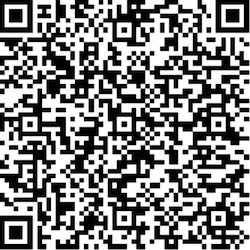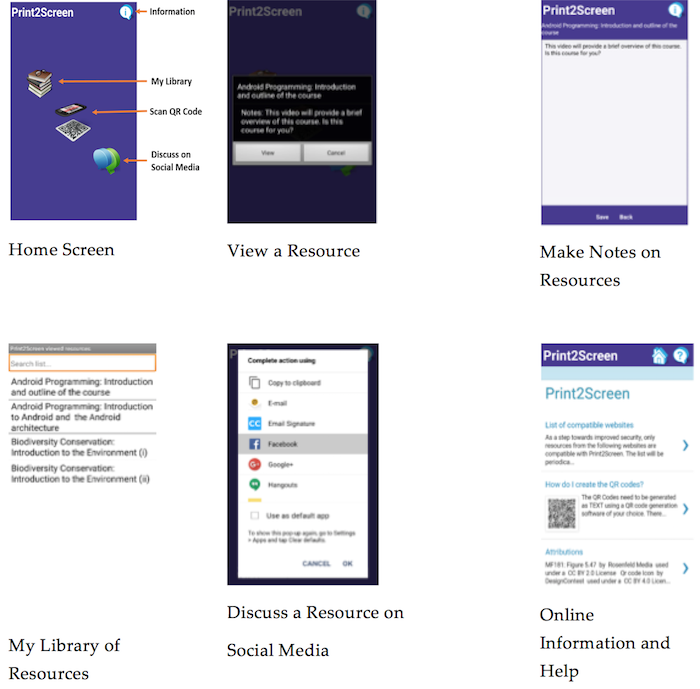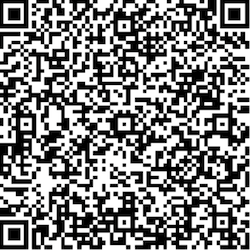
VOL. 4, No. 3
Abstract: With the rise of OER and multimedia such as YouTube videos, many academic institutions are becoming mindful of the richness they bring into the teaching and learning process. Given that multimedia resources cannot be directly integrated into printed material, the only available alternative is to print hyperlinks, which teachers and learners can manually type into a web browser. This method becomes ridiculously ineffective as the length of the URL increases. To address this limitation with a special focus on print based ODL course materials, the Commonwealth Educational Media Centre for Asia (CEMCA), which is a regional centre of the Commonwealth of Learning (COL), developed an innovative solution to seamlessly integrate multimedia into printed material using Quick Response Codes (QR codes) or 2D barcodes and an Android mobile application named “Print2Screen”. This paper highlights the rationale behind Print2Screen, the development process, how the solution is implemented in a real world scenario and the benefits it will bring to the ODL community especially in rural and developing parts of the world where stable access to technology is still a costly commodity.
The world is rapidly moving towards a digital culture where teaching and learning is migrated to cyberspace from a conventional brick and mortar classroom. Given that eLearning and mobile learning are attractive propositions for countries with robust technological infrastructure, the global south is still struggling to mainstream digital methods of delivering education due to various technological and financial inhibitors. This has spelled a potential slow death for printed material in developing countries where the medium is predominantly used for delivering education in schools, conventional universities, vocational training institutions and open universities.
With increased emphasis on enriching the traditional teaching and learning processes through the inclusion of open educational resources (OER) and multimedia such as YouTube videos (Merkt, Weigand, Heier, & Schwan, 2011), educators have been forced to innovate new methodologies to bring the two realms together. In this context, new pedagogies such as flipped classrooms (Kim, Kim, Khera, & Getman, 2014), massive open online courses or MOOCs (deWaard, et al., 2011) and mobile learning (Herrington, Herrington, Mantei, Olney, & Ferry, 2009) have come to the rescue of those mavericks who want to harness technology to transform the way they teach and the way the learners learn. Given that these innovative approaches are radicalizing teaching and learning, the digital divide has become more prominent between the global North and South in terms of access to high-speed Internet, computer literacy and technology infrastructure (Liyanagunawardena, Williams, & Adams, 2013). Furthermore, many academics are unwilling to make the move towards going completely digital (Straumsheim, 2016). Thus, a significant need has arisen to identify new methodologies to ensure that a learner in a developing country, using printed study materials due to limited access to technology, would have the same enrichment through multimedia and digital resources as a more privileged Western counterpart. In recent times, the advent of mobile devices and smartphones with relatively low-cost mobile Internet access has acted as an agent for reducing the digital divide. Based on their study in Armenia, Pearce and Rice (2013, p. 17) argue:
…relatively early on in the widespread diffusion of the Internet in Armenia (via PC, mobile, or both), access to the Internet by mobile phones is more likely by lower sociodemographic levels and those with lower English skills. This result supports the notion that this device may be an alternative route to Internet resources and thus reduce some gaps over time, compared to the traditional PC-based Internet use, with its attendant access, technology, complexity, skill, and cost factors.
From his study of minorities in the USA, Prieger (2015, p. 18) states:
Some evidence indicates that minorities use broadband Internet access to address and remedy deficiencies in human capital. For example, a survey conducted by the FCC found that African Americans are significantly more likely to take online classes than whites by a margin of 37% to 22% (Horrigan, 2010). The importance of the Internet for finding employment is also greater for African Americans, with African Americans being more likely than whites (83% versus 55%) to go online to get information about or apply for a job.
Given the penetration, mobile devices and mobile Internet access have become the logical choice for new innovation aimed at blending traditional printed course delivery with multimedia and digital resources. In this regard, the use of Quick Response Codes (QR codes) or 2 Dimensional barcodes (2D barcodes) are making headway in the academic community (Ozcelik & Acarturk, 2011).
QR codes or 2D barcodes (Figure 1) were first introduced by a Japanese company in 1994. These types of barcodes were designed for inventory tracking and were given the name “Quick Response” as they were intended to be read and decoded at high speeds. Technologically, a QR code is a matrix code, which is developed to contain information in both vertical and horizontal directions, whereas a regular barcode has only one direction. Therefore, a QR code can hold a considerably greater amount of information. Another benefit is that data can be recovered even when the QR code is damaged or when parts are missing (Rouillard, 2008).

Figure 1: An example of a QR code
Uluyol and Agca (2012) introduced a text-plus-mobile model where 2D barcodes are encoded with web URLs, which host related animations, embedded in textbooks. Their results revealed that the participants in the text-plus-mobile phone condition had higher retention and transfer scores than the participants in other conditions. They also found significant differences between the text-plus-mobile phone condition and the text-only and text-plus-picture conditions on retention and transfer scores. Agca and Özdemir (2013) used Microsoft Tag technology in conjunction with printed books to facilitate learning of English language as a foreign language. Their findings show that the environment created curiosity for students and made the vocabulary learning activity more attractive by motivating students in a positive way. A similar study was conducted by Liu, Tan and Chu (2010), who used QR codes and augmented reality in teaching English. QR codes have also been used in library systems where collections are coded into QR codes and made available as printed pamphlets or online on the library webpage (Ashford, 2010). Another application is to use QR codes in conjunction with GPS technology to deliver location-aware content to learners (Chin & Chen, 2013). Further, QR codes have been used in classroom noticeboards to provide students with additional information via the Internet (Chaisatien & Akahori, 2007).
The Print2Screen app described in this research paper focuses not only on using QR codes to embed information but also to assist learners in their learning process by keeping persistent records and allowing social learning. The next sections describe the technology and implementation strategy of the Print2Screen system in the distance learning environment.
The traditional method of integrating multimedia such as YouTube videos into a printed course material is to provide a URL, which the learner could type into a browser. With more complex URLs, this becomes a tedious and inefficient task. The Print2Screen app attempts to address this issue by allowing learners to access multimedia resources referred to in a printed material through the use of a mobile phone or tablet.
Print2Screen is the second generation of the Android mobile app “AugmenLearn” designed and developed by the Commonwealth Educational Media Centre for Asia (CEMCA), India, which is a regional centre of the Commonwealth of Learning (COL), Canada. The Android operating system (OS) is arguably dominating the current smartphone and tablet market. The Free and Open Source Software (FOSS) frameworks and ease of use have made it the most sought-after OS for use by manufacturers. Due to its commitment to open, FOSS nature and penetration, Android OS was chosen as the platform for the Print2Screen app. Furthermore, the app was developed using the MIT App Inventor 2 (http://ai2.appinventor.mit.edu) cloud-based FOSS development platform, utilizing the concepts of visual programming where no programming code was written. This allows the app to be easily customizable by teachers and learners who have no prior programming experience (Abeywardena, 2015). The key sections of the Print2Screen app are shown in Figure 2. The key features of the Print2Screen app are described in Table 1.
Print2Screen compatible QR codes contain more information than a regular QR code, which may only have a URL encoded. A Print2Screen compatible QR code has the Title, Description/Notes and URL encoded into it to enhance the learning experience. The QR Codes need to be generated as TEXT using QR code generation software. There are many free QR code generators available online such as, http://www.qr-code-generator.com, http://goqr.me and https://www.the-qrcode-generator.com. The string for generating a Print2Screen compatible QR code should be in the following format separated by semicolons:
Resource URL; Title of resource; Notes (e.g. brief descriptions. Questions etc.)
The following is an example of a string used to generate Print2Screen compatible QR codes:
https://www.youtube.com/watch?v=xyub1qIbha8&index=2&list=PLXN-JCVb8z8DS1umCwF2cvJoIgxSDRP4j; Techniques of Critical Thinking; This is a short video that explains how to acquire and develop techniques of Critical Thinking and what are the obstacles or hurdles in critical thinking.
The Print2Screen compatible QR code for the above string is shown in Figure 3.
Table 1: Key Features of the Print2Screen App
| Feature | Description |
Home Screen |
Gives access to the key features of the app from one convenient location. Learners can scan the QR codes, check My Library for previously viewed resources, share and discuss resources on their social media platforms and access online help/information. |
Scan QR Code |
The app will launch the camera of the phone to scan the Print2Screen compatible QR code. Once the QR code is scanned, it will provide the title and notes for the particular multimedia resource. The learner is able to view or cancel at this point depending on the information provided. If the learner chooses to view, the resource is automatically added to the “My Library” for easy access. |
My Library |
Provides a listing of all the resources viewed. It also provides a search feature, which allows the learner to search for a particular resource within the library. Through the My Library, learners can access pre-defined notes for a particular resource. They can also add new notes for a particular resource, which will help in revision. |
Discuss on Social Media |
Learners are able to share a resource they have viewed through social media such as Facebook or twitter and discuss with peers, tutors and teachers. They can also use this feature to send direct emails or text messages to the tutors or teachers highlighting doubts or clarifications. |
Online Information and Help |
Provides learners with a dynamic list of Frequently Asked Questions (FAQs) assisting them on how to use the Print2Screen app and how to create compatible QR codes. |

Figure 2: Key sections of the Print2Screen app.

Figure 3: Print2Screen compatible QR code
As a step towards improved security, only resources from trusted websites are compatible with Print2Screen (e.g., col.org, cemca.org.in, oasis.col.org, youtube.com, vimeo.com, nptel.ac.in, commons.wikimedia.org, and www.flickr.com).
The primary target audience for the Print2Screen app is distance learners from developing countries who depend on printed course material and mobile Internet. The augmentation of printed material with multimedia, such as video, and the availability of social learning features, such as messaging, allows learners to have a richer learning experience whilst potentially achieving the set learning outcomes.
The alpha version of the application was circulated to five partner institutions where they tested it for two weeks. At the end of the alpha testing stage, feedback was provided which was used to improve the Print2Screen system as a beta version for public use.
The beta version of the appFN1 is available for the Android OS and can be downloaded free of charge from the Google Play Store for smartphones and tablets running the Android OS.
As a pilot, Print2Screen compatible QR codes were generated and embedded into four ODL courses, which had approximately 10 supplementary video lectures each. The courses were:
Figure 4 demonstrates how the Print2Screen compatible QR codes are embedded in one of the courses.

Figure 4: A Print2Screen compatible QR code embedded in the Biodiversity Conservation course
The courses, which are available as OER under a CC BY 4.0 International License, are currently being offered to learners in Graphic Era Hill University, India. Further, the technology was introduced to COL’s Innovation in Vocational Education and Skills Training (INVEST) Africa teacher group, during a capacity building workshop conducted in Nakuru, Kenya. Some initial feedback gathered from the group using the INVEST Africa community of practice is as follows:
I have used P2S app for android. I have noticed that it can be a quick way of capturing information if one is reading and would require to note information for further reference.
I have used the P2S app a number of times and it worked perfectly well. I will recommend it for the print-based flexible learning materials.
Easy to use for me. I downloaded the App, It’s interesting to view the document after capturing.
As future work, the user experience of using the Print2Screen app will be surveyed in the next stage of implementation.
Bridging the gap between printed course materials and multimedia, such as YouTube videos, is a challenge that needs to be overcome by modern educators who aspire to bring new pedagogical approaches to traditional modes of delivery. In this light, the use of mobile technologies and QR codes — or 2D barcodes — have gained the attention of practitioners as a means of building interactivity and multimedia into static printed course material. Print2Screen is an Android mobile application, which harnesses the power of QR codes to enrich the learning experience of users who are still dependent on printed course materials due to various socio-economic and technological barriers. The app allows learners to view multimedia embedded in printed course material using a smartphone or mobile device. It also has the ability to keep a library of resources viewed, add notes to a particular resource for future reference and share a resource on social media for social learning. The app is currently in the beta testing phase and is being piloted in four ODL courses. The Print2Screen app can be downloaded free of charge from the Google Play Store.
An initial version of this paper was presented at the 8thPan-Commonwealth Forum (PCF8), Kuala Lumpur, Malaysia in November 2016; Dr Alison Mead Richardson is acknowledged for all the support provided in beta testing the Print2Screen app through the INVEST Africa group; Dr Shahid Rasool and CEMCA for the support provided in hosting and publishing the app on Google Play; and Dr Ramesh Sharma for the support provided in conceptualizing the first generation of the app.
Abeywardena, I. S. (2015). Educational app development toolkit for teachers and learners. Vancouver: Commonwealth of Learning. Retrieved from http://oasis.col.org/handle/11599/1729
Agca, R. K., & Özdemir, S. (2013). Foreign language vocabulary learning with mobile technologies. Procedia-Social and Behavioral Sciences, 83, 781-785. Retrieved from http://www.sciencedirect.com/science/article/pii/S1877042813012147
Ashford, R. (2010). QR codes and academic libraries Reaching mobile users. College & Research Libraries News, 71(10), 526-530. Retrieved from http://crln.acrl.org/content/71/10/526.short
Chaisatien, P., & Akahori, K. (2007, July). A pilot study on 3G mobile phone and two dimension barcode in classroom communication and support system. Seventh IEEE International Conference on Advanced Learning Technologies (ICALT 2007), (pp. 111-113). Retrieved from this URL.
Chin, K. Y., & Chen, Y. L. (2013). A mobile learning support system for ubiquitous learning environments. Procedia-Social and Behavioral Sciences, 73, 14-21. Retrieved from http://www.sciencedirect.com/science/article/pii/S1877042813003066
deWaard, I., Koutropoulos, A., Keskin, N., Abajian, S. C., Hogue, R., Rodriguez, C. O., & Gallagher, M. S. (2011). Exploring the MOOC format as a pedagogical approach for mLearning. In Proceedings of 10th World Conference on Mobile and Contextual Learning, (pp. 138-145). Retrieved from http://www.academia.edu/download/32377703/Conference_Procedings.pdf#page=149
Herrington, J., Herrington, A., Mantei, J., Olney, I., & Ferry, B. (2009). Using mobile technologies to develop new ways of teaching and learning. In J. Herrington, M. J, I. Olney, B. Ferry, & A. Herrington (Eds.), New technologies, new pedagogies: Mobile learning in higher education (pp. 1-14). Wollongong: University of Wollongong. Retrieved from http://researchrepository.murdoch.edu.au/5227/1/Using_Mobile_technologies.pdf
Horrigan, J. (2010). Broadband adoption and use in America. Federal Communications Commission. Retrieved from http://hraunfoss.fcc.gov/edocs_public/attachmatch/DOC-296442A1.pdf
Kim, M. K., Kim, S. M., Khera, O., & Getman, J. (2014). The experience of three flipped classrooms in an urban university: an exploration of design principles. The Internet and Higher Education, 22, 37-50. Retrieved from http://www.academia.edu/download/33655841/The_Experience_of_Three_Flipped_Classrooms_in_an_Urban_University-_An_Exploration_of_Design_Principles.pdf
Liu, T. Y., Tan, H., T., & Chu, Y. L. (2010). QR code and augmented reality-supported mobile English learning system. Proceedings of Mobile Multimedia Processing (pp. 37-52). Springer Berlin Heidelberg. Retrieved from http://sites.psu.edu/mobilelearners/wp-content/uploads/sites/6345/2013/10/QR-Code-and-Augmented-Reality-Supported-Mobile-English-Learning-System.pdf
Liyanagunawardena, T., Williams, S., & Adams, A. (2013). The impact and reach of MOOCs: A developing countries’ perspective. eLearning Papers(33). Retrieved from http://centaur.reading.ac.uk/32452/
Merkt, M., Weigand, S., Heier, A., & Schwan, S. (2011). Learning with videos vs. learning with print: The role of interactive features. Learning and Instruction, 2(6), 687-704. Retrieved from http://citeseerx.ist.psu.edu/viewdoc/download?doi=10.1.1.477.3414&rep=rep1&type=pdf
Ozcelik, E., & Acarturk, C. (2011). Reducing the spatial distance between printed and online information sources by means of mobile technology enhances learning: Using 2D barcodes. Computers & Education, 57(3), 2077-2085. Retrieved from this URL.
Pearce, K. E., & Rice, R. E. (2013). Digital divides from access to activities: Comparing mobile and personal computer Internet users. Journal of Communication, 63(4), 721-744. Retrieved from http://www.academia.edu/download/31556616/jcom12045.pdf
Prieger, J. E. (2015). The broadband digital divide and the benefits of mobile broadband for minorities. The Journal of Economic Inequality, 13(3), 373-400. Retrieved from http://digitalcommons.pepperdine.edu/cgi/viewcontent.cgi?article=1044&context=sppworkingpapers
Rouillard, J. (2008). Contextual QR codes. In The Third International Multi-Conference on Computing in the Global Information Technology (pp. 50-55). IEEE.
Straumsheim, C. (2016). No Rush to 'Go Digital'. INSIDE HIGHER ED. Retrieved 02 23, 2016, from https://www.insidehighered.com/news/2016/02/22/studyfacultymembersskepticaldigitalcoursematerialsunfamiliaroer
Uluyol, C., & Agca, R. K. (2012). Integrating mobile multimedia into textbooks: 2D barcodes. Computers & Education, 59(4), 1192-1198. Retrieved from http://www.sciencedirect.com/science/article/pii/S036013151200139X
Author:
Dr. Ishan Sudeera Abeywardena is Advisor: Open Educational Resources at the Commonwealth of Learning. Email: iabeywardena@col.org